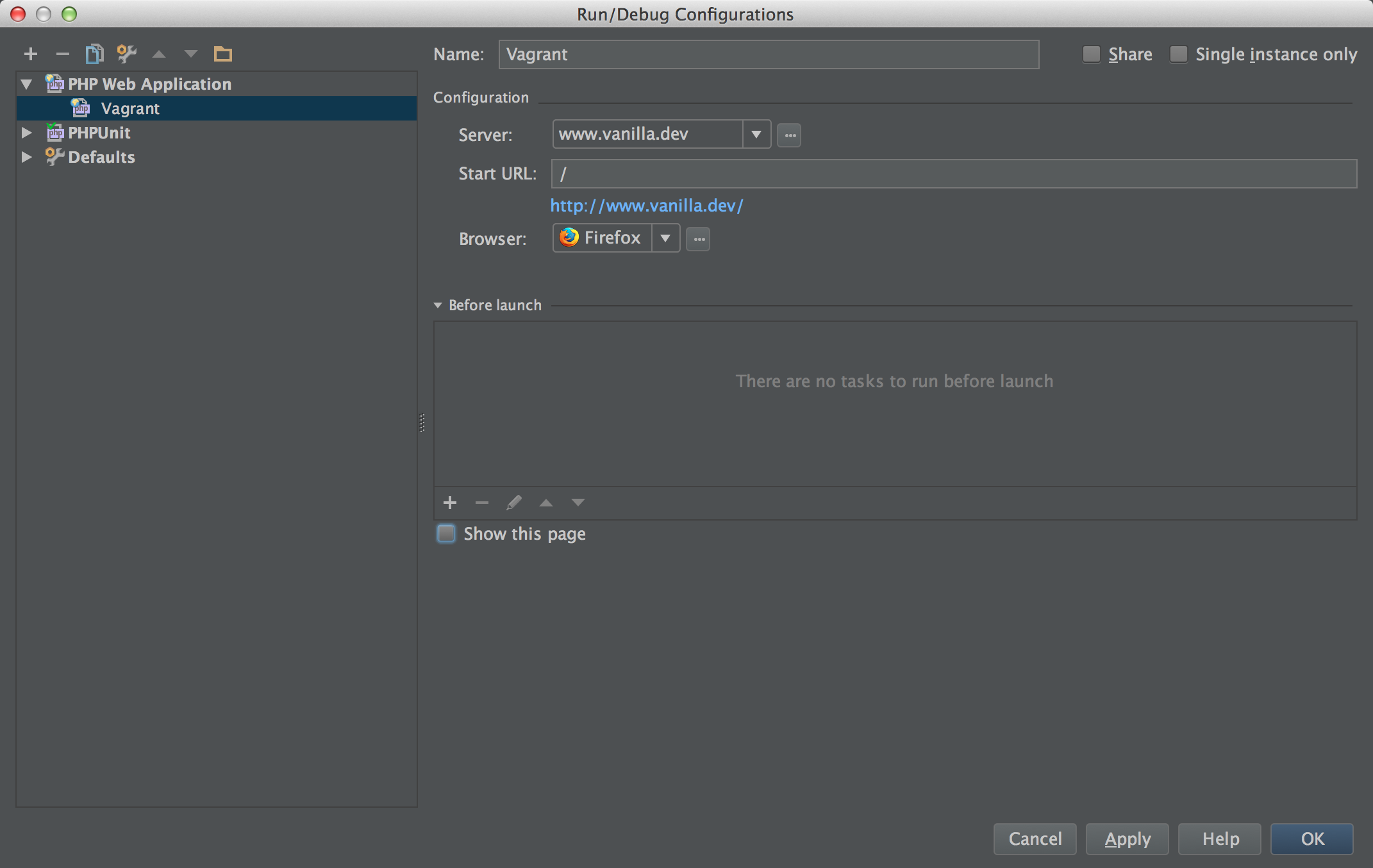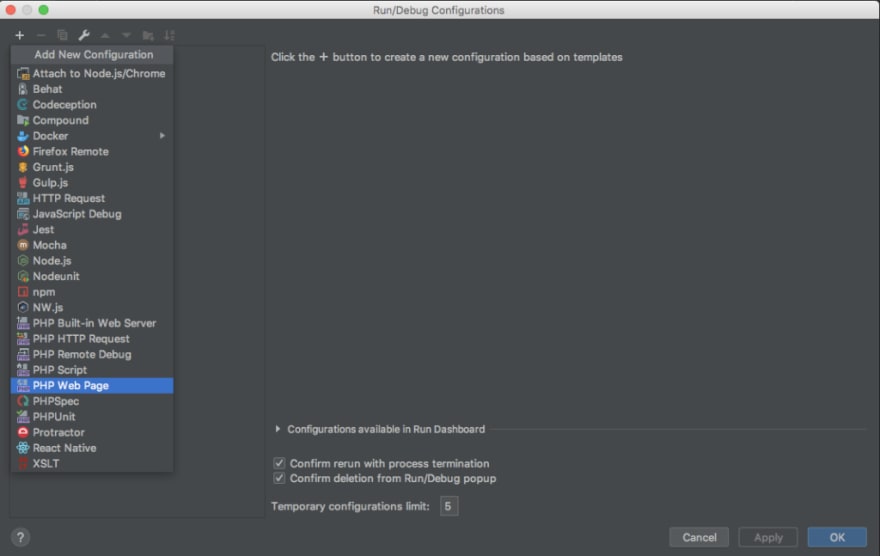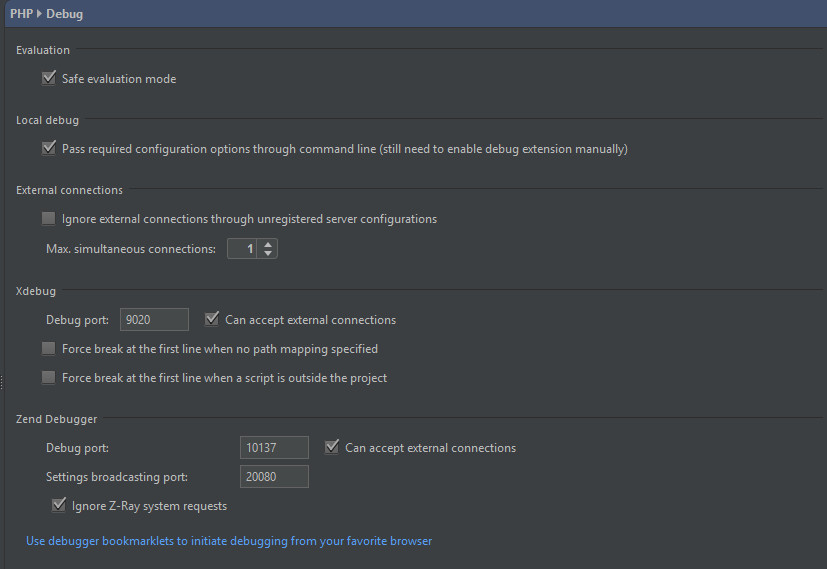Vagrant is a command-line utility used to manage the lifecycle of virtual machines.
PhpStorm provides a full integration with Vagrant allowing you to configure the Vagrant virtual environment, control the behavior of virtual machines, and execute Vagrant commands from within your project.
In the context of working with Vagrant, you will meet the following definitions:
Using Xdebug in PhpStorm with a Vagrant VM managed with PuPHPet Installation and configuration In PuPHPet configuration file config.yaml. Make sure Xdebug is enabled (install: '1') set xdebug.remoteconnectback to 0. Add xdebug.remotehost. Set it to 10.0.2.2. I have configured the path mappings in PHPStorm, so for instance V: dev on Windows is mapped to /home/vagrant/dev on vagrant (running Ubuntu). All seems to be working fine except for the code coverage which always shows 0% for all files, and with no lines covered at all. Debugging with xdebug and PhpStorm The basic idea in PhpStorm is that you tell it where to look for the xdebug session (the “server”) and then you tell it how to link the files it’s running in the VM to the files found in the repo (called “mapping”). What follows are opinionated defaults, so adjust as. 📌 Let's review how to get Vagrant (w/ Ubuntu) & xDebug & PHPStorm Installed and configured. There are two prerequisites to this video: 1️⃣ Vagrant Installati.
Vagrantfile: the main configuration file that defines the Vagrant environment, stores all the configuration for the virtual boxes and tells Vagrant how to work with virtual machines.
Virtual box: a virtual sandbox that contains a preconfigured virtual machine. Vagrant works with different providers of virtual boxes, such as Oracle's VirtualBox, VMWare or AWS.
Instance: a virtual machine.
In this article, we will explain how to initialize the Vagrantfile, specify the virtual box, run and interact with the virtual machine from PhpStorm.

Prerequisites
Install and enable Vagrant plugin as described in Installing plugins from JetBrains repository.
Install Vagrant and Oracle's VirtualBox applications.
Make sure virtualization is enabled on your computer.
Initialize the Vagrantfile
To start working with Vagrant, you need to initialize the Vagrantfile.
Do one of the following:
Open the embedded Terminal (Alt+F12) and run the following command:
vagrant initThis will initialize the Vagrantfile and put it into your project root folder by default.
From the main menu, choose Tools | Vagrant | Init in Project Root and select the target root folder from the opened window.
In the Project tool window Alt+1, switch to the Project files view and double-click the Vagrantfile to open it in the embedded editor.
You will see that Vagrantfile already has a predefined configuration. The config.vm.box = '..' line specifies the virtual box that will be used in a project.
Specify the virtual box
As an example, we will specify the ubuntu/trusty64 box. Download excel mac gratis. It contains a basic Ubuntu virtual machine. You can specify any other virtual box based on your needs. To find a list of available virtual boxes, refer to Discovering Vagrant Boxes.
Do one of the following:
Open the Vagrantfile and change
config.vm.box = 'base'line to the following:config.vm.box = 'ubuntu/trusty64'.In the Settings/Preferences dialog (Ctrl+Alt+S ), select Tools | Vagrant. In the Boxes window click the button and specify the following:
Box name: ubuntu/trusty64
Box URL: https://app.vagrantup.com/ubuntu/boxes/trusty64
All the downloaded boxes are stored in the location of the Vagrantfile. To change the default root folder for the virtual boxes, open the Settings/Preferences dialog (Ctrl+Alt+S ), select Tools | Vagrant and change the Instance folder location.
Once the Vagrantfile initialization is completed and virtual box is specified, you are ready to deploy and run the virtual machine.
Launch an instance

Do one of the following:
Open the embedded Terminal (Alt+F12) and run the following command:
vagrant up.You will see the following output: Asphalt 6 mac download.
From the main menu, choose Tools | Vagrant | Up.
SSH into a running machine
When the virtual machine is launched, it runs on a backend. To SSH into a running machine:
Php Docker Xdebug Phpstorm
Open the embedded Terminal (Alt+F12) and run the following command:
vagrant ssh
Vagrant commands to control an instance
To control an instance, use Vagrant commands. They can be run either from Terminal (Alt+F12) or from the main menu.

In this article, we show only the most important commands to work with the virtual machine. To find a full list of available Vagrant commands, refer to Command-Line-Interface.

Suspend: suspending an instance pauses all the processes and saves the current state of a virtual machine.
Run
vagrant suspendin Terminal or select Tools | Vagrant | Suspend from the main menu.Resume: resuming an instance brings up a previously suspended virtual machine.
Run
vagrant resumein Terminal or select Tools | Vagrant | Resume from the main menu.Reload: reloading an instance is required when you've made changes to the Vagrantfile and need Vagrant to reload the current virtual environment and its configuration.
Run
vagrant reloadin Terminal or select Tools | Vagrant | Reload from the main menu.Shut down: shutting down an instance stops the running virtual machine.
Run
vagrant haltin Terminal or select Tools | Vagrant | Halt from the main menu.Destroy: destroying a virtual machine is important when you need to remove everything related to the previously created environment. All the resources provisioned during the creation of an instance are removed.
Run
vagrant destroyin Terminal or select Tools | Vagrant | Destroy from the main menu.
PhpStorm supports debugging for PHP applications, classes, and files. The debugging functionality is incorporated in PhpStorm, you only need to configure its settings.
In PhpStorm, the JavaScript debugger works out of the box and in most cases its default settings are sufficient. If necessary, you can configure the debugger as described in Configuring JavaScript debugger.
PhpStorm supports debugging client-side applications running on the built-in or an external web server. Debugging can be performed only using Google Chrome and other browsers of the Chrome family.

This section describes how to configure two most common PHP debugging engines:
Phpstorm Setup Xdebug
These tools cannot be used simultaneously because they block each other. To avoid this problem, you need to update the corresponding sections in the php.ini file.
Xdebug Php
The Ultimate Debugging Guide will provide you with comprehensive step-by-step instructions on debugging in PhpStorm.
